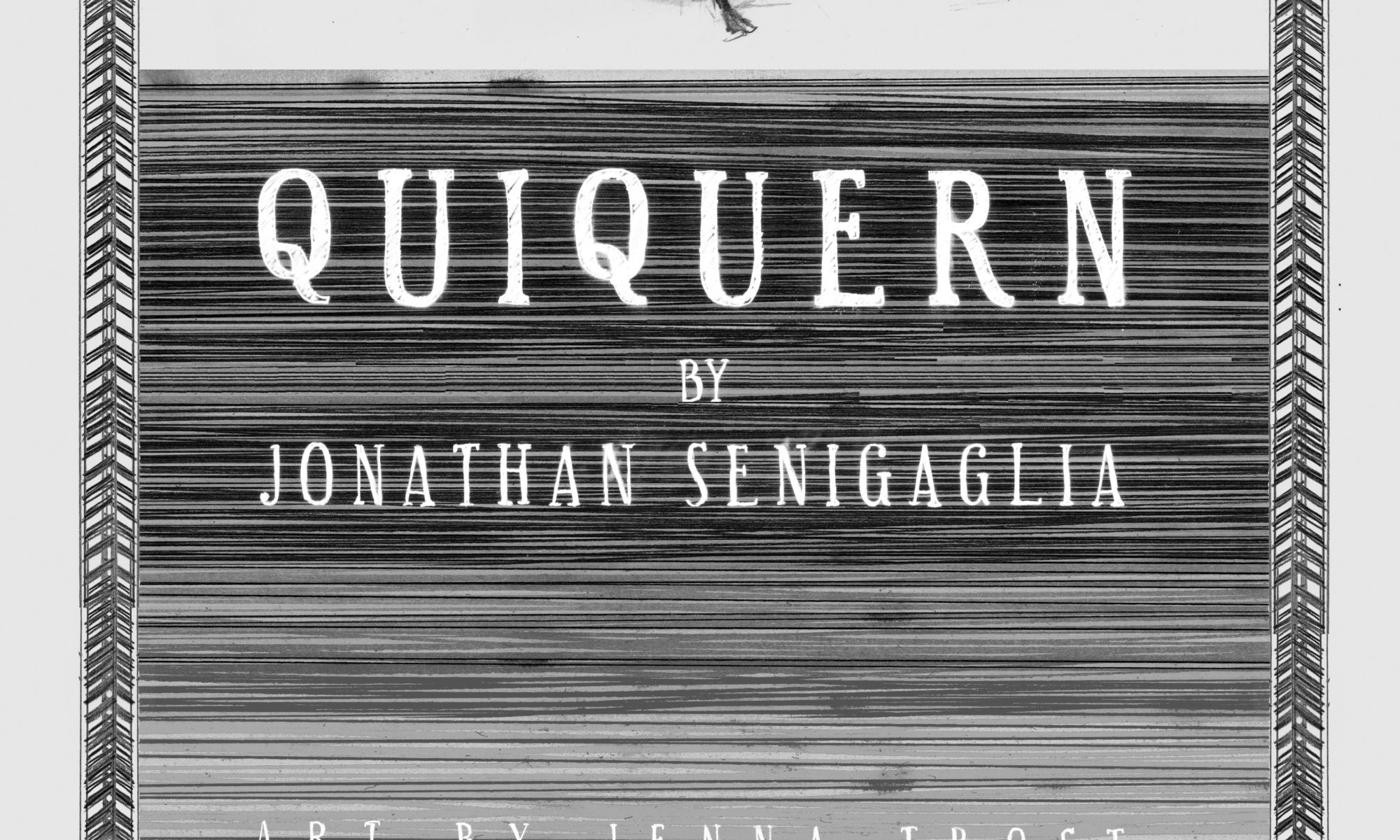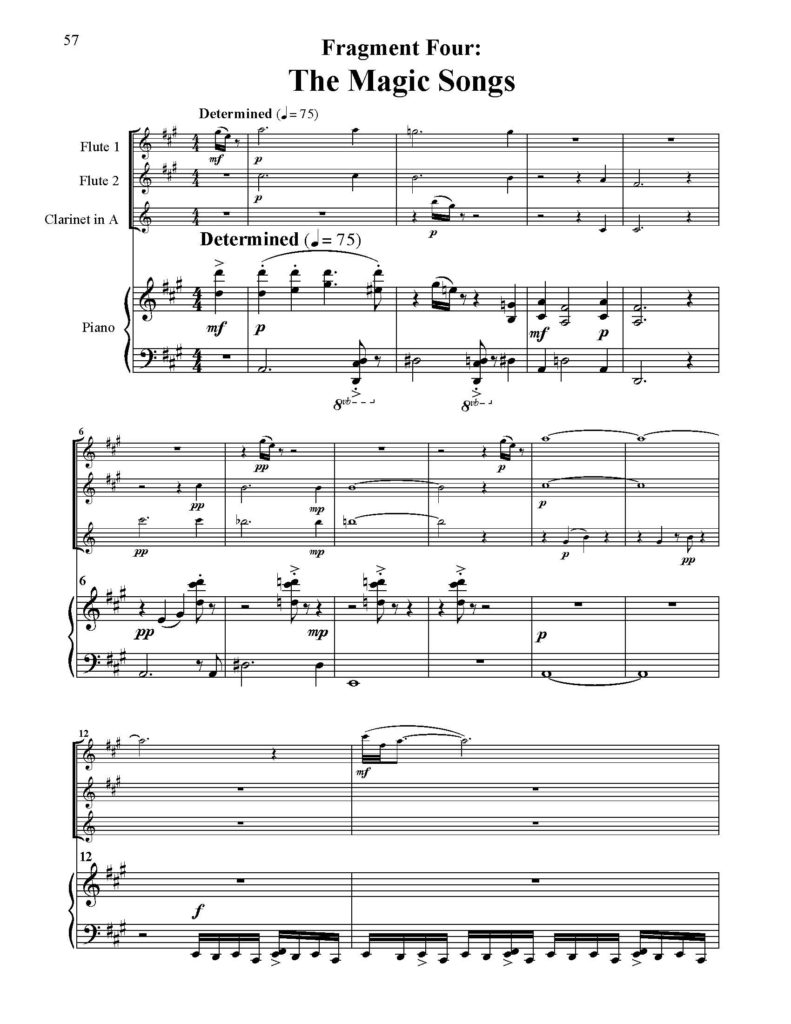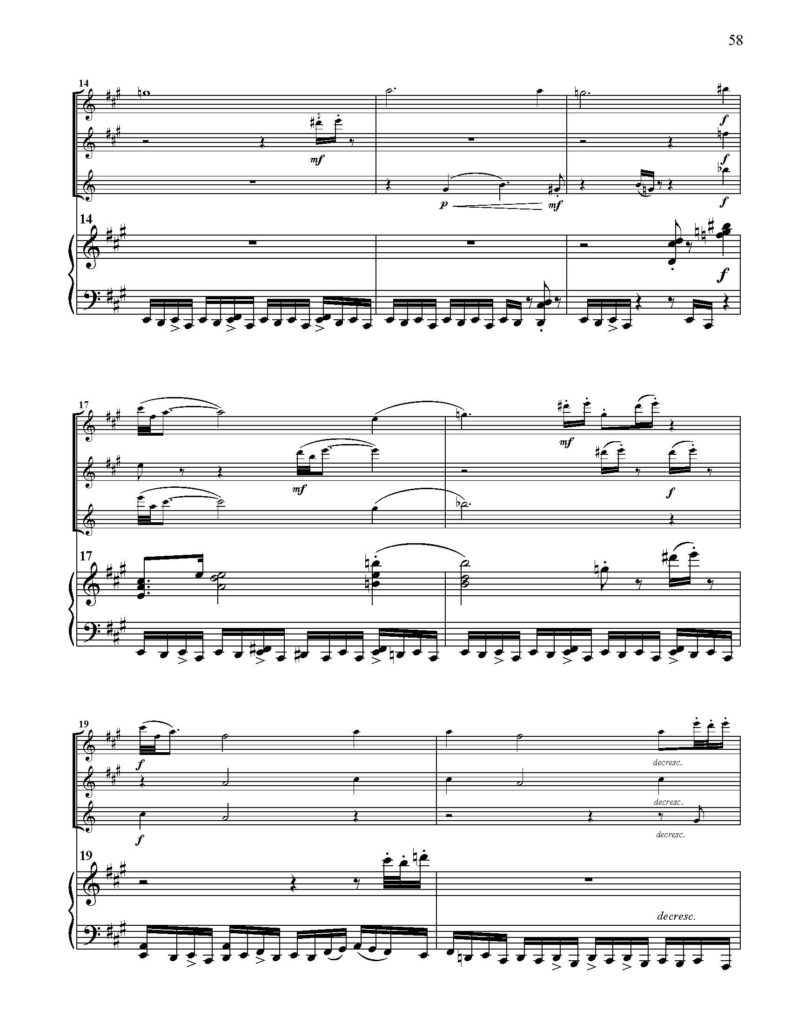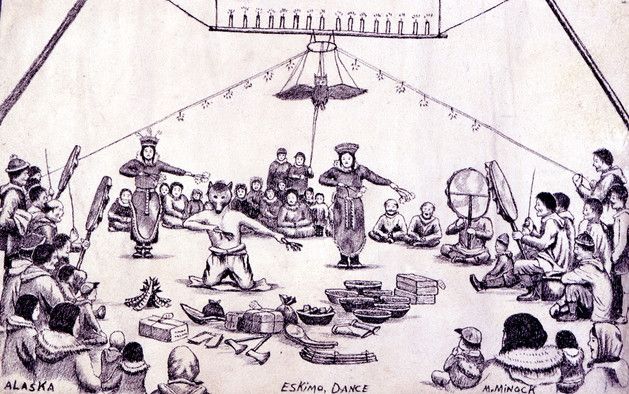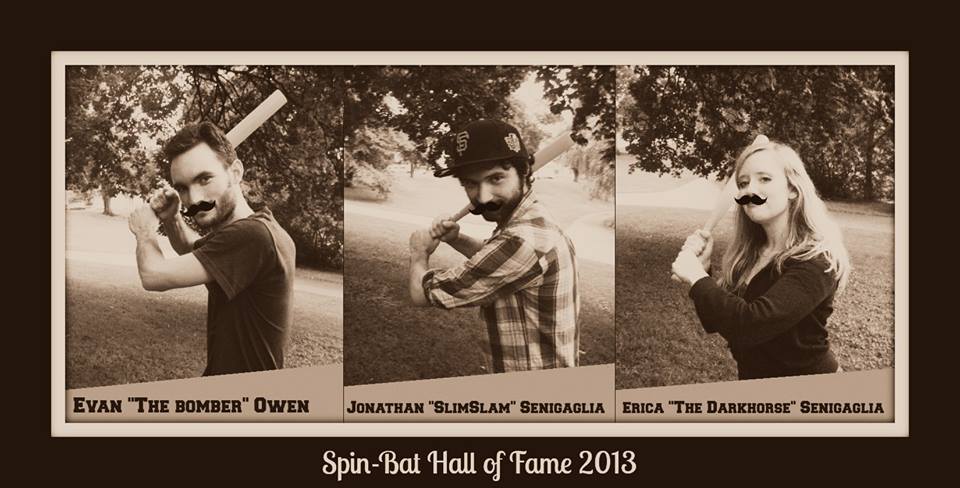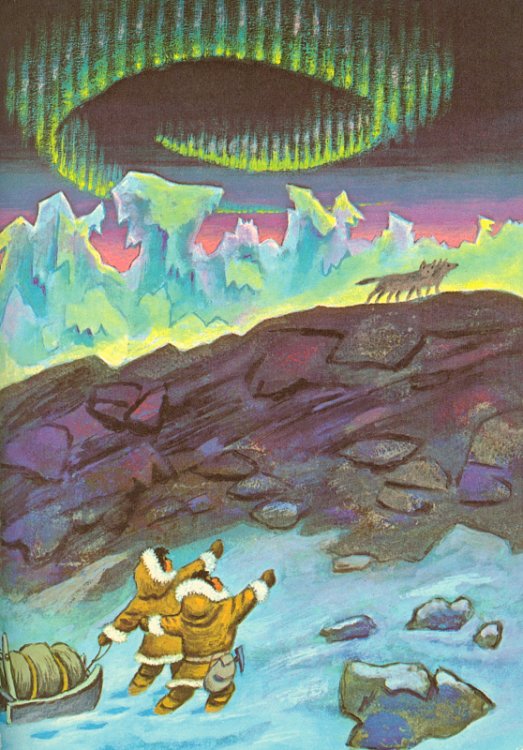Quiquern is a five movement piece of music for piano, two flutes, and a clarinet, based on a short story by Rudyard Kipling.
Here is the story behind the music .Quiquern: The Magic Songs and Hunter’s Return
This next fragment of Quiquern is called “The Magic Songs”. Famished and delirious, Young Kotuko and the girl set out alone into the blizzard to find food for the starving village. As the dark and the cold and hunger devour them, the two children rave and hallucinate, unhinging themselves from the realm of men and into the realm of gods. As they descend, they sing songs of magic, songs buried deep in their memories, in their blood. Their voices rise and fall with the frozen wind.
And through this silence and through this waste, where the sudden lights flapped and went out again, the sleigh and the two that pulled it crawled like things in a nightmare — a nightmare of the end of the world at the end of the world.
The girl was always very silent, but Kotuko muttered to himself and broke out into songs he had learned in the Singing–House — summer songs, and reindeer and salmon songs — all horribly out of place at that season. He would declare that he heard the tornaq growling to him, and would run wildly up a hummock, tossing his arms and speaking in loud, threatening tones. To tell the truth, Kotuko was very nearly crazy for the time being; but the girl was sure that he was being guided by his guardian spirit, and that everything would come right. She was not surprised, therefore, when at the end of the fourth march Kotuko, whose eyes were burning like fire-balls in his head, told her that his tornaq was following them across the snow in the shape of a two-headed dog. The girl looked where Kotuko pointed, and something seemed to slip into a ravine. It was certainly not human, but everybody knew that the tornait preferred to appear in the shape of bear and seal, and such like.
It might have been the Ten-legged White Spirit–Bear himself, or it might have been anything, for Kotuko and the girl were so starved that their eyes were untrustworthy. They had trapped nothing, and seen no trace of game since they had left the village; their food would not hold out for another week, and there was a gale coming. A Polar storm can blow for ten days without a break, and all that while it is certain death to be abroad. Kotuko laid up a snow-house large enough to take in the hand-sleigh (never be separated from your meat), and while he was shaping the last irregular block of ice that makes the key-stone of the roof, he saw a Thing looking at him from a little cliff of ice half a mile away. The air was hazy, and the Thing seemed to be forty feet long and ten feet high, with twenty feet of tail and a shape that quivered all along the outlines. The girl saw it too, but instead of crying aloud with terror, said quietly, “That is Quiquern. What comes after?”
This is the final music of Quiquern. At the end of the story, the dogs lead the boy and girl to a crack in the ice where seals are coming up for air. They kill as many seals as they can carry, and hurry them back to the village. The people rejoice as famine is averted just in time. They sing and light candles made of seal fat.
Kotuko and the girl took hold of hands and smiled,
for the clear, full roar of the surge among the ice
reminded them of salmon and reindeer time
and the smell of blossoming ground-willows.
Even as they looked, the sea began to skim over
between the floating cakes of ice,
so intense was the cold;
but on the horizon there was a vast red glare,
and that was the light of the sunken sun.
It was more like hearing him yawn
in his sleep than seeing him rise,
and the glare lasted for only a few minutes,
but it marked the turn of the year.
Nothing, they felt, could alter that.
This ending seems to think of itself as a happy ending. But that’s not really what it is. It’s not a sad ending either. The village is well-fed for today, and their way of life continues the way it has for a thousand years. There is something truly magical about that. But what happened this winter will happen again. The village’s survival is always balanced precariously upon a precipice. As the camera pans out, we are reminded that all around the happy village is an endless frozen desert, cruel and dark, and so very cold. A single warm ember in a vast field of ice.
Perhaps that is a metaphor for all of humanity. Everything that we do and everything we care about and everything we’ve ever created and everything we remember and cherish is but a tiny ember in the blackness of space. How hard we all try to keep it lit; how vast and cold and uncaring is the universe.
Does that mean we shouldn’t live our lives to the fullest? Of course not! It’s even more reason to appreciate life. The feel of a baby’s skin on one’s cheek, the laughter of a life-long friend, the warm embrace of a lover, the taste of well-prepared food, the memories of good times, the hopes and dreams and aspirations we all nurture in our hearts; these things keep us warm and snug through the winters of life, even if deep down we know that the dark need not attack us directly to see us finally defeated, it need only wait.
Who Am I Stealing From Today? (David Wise)
In early January, full of fresh energy and creative juice, I saw the music in a different light and dove headfirst into some new material. In two days I created an entirely original fragment: The Singing House.
Fragment 3: Quaggi – The Singing House
Come on a musical journey with me.
On the far side of the village is the Quaggi – The Singing House. Only men may enter; it is where they go to pray. In times of plenty, the men sing hearty songs of gratitude to the various gods of the Arctic. In times of desperation, they fall into a trance of smoke and dark and sweat and hunger. Arms linked, stomping the holy ground, repeating of the same syllables, the great hunters of the village reach for the gods with outstretched arms.
What does a 10 year old boy imagine of this place? Banned from entering, just like the women, but knowing in his heart, unlike the women, that one day he will be granted entry into the inner sanctum, a young boy of the village can only guess what goes on inside that large tent. He hears from a friend that the sorcerer sings his magic songs and calls upon the Spirit of the Reindeer, and his songs make the wind blow and the ice crack to reveal the seal below. Anxiety and yearning and fear wiggle through his body. One day he would take his place in the Quaggi and learn the secrets of the hunters.
But at fourteen an Inuit feels himself a man, and Kotuko was tired of making snares for wild-fowl and kit-foxes, and most tired of all of helping the women to chew seal-and deer-skins (that supples them as nothing else can) the long day through, while the men were out hunting. He wanted to go into the quaggi, the Singing–House, when the hunters gathered there for their mysteries, and the angekok, the sorcerer, frightened them into the most delightful fits after the lamps were put out, and you could hear the Spirit of the Reindeer stamping on the roof; and when a spear was thrust out into the open black night it came back covered with hot blood.
I should also note that I openly plagiarized the work of another composer in this piece: David Wise, who wrote all the music from Donkey Country (1 and 2). Here’s the tune I stole:
So good right?
The music from this game was the running soundtrack of my childhood. When I was in middle school, I used to pretend I was in a band (perhaps in some jazzy night club) performing this very song. This music shaped me and my compositional style. I feel honored to sample this man’s music.
The form of “Quaggi” is reminiscent of video game music. The first section is a long musical segment consisting of variations on a couple themes. It then repeats. In fact it could repeat on loop and just BE video game music.
Thoughts on Quiquern: Music can reveal that all humans are one family
(Hit Ctrl+ to read this journal entry).

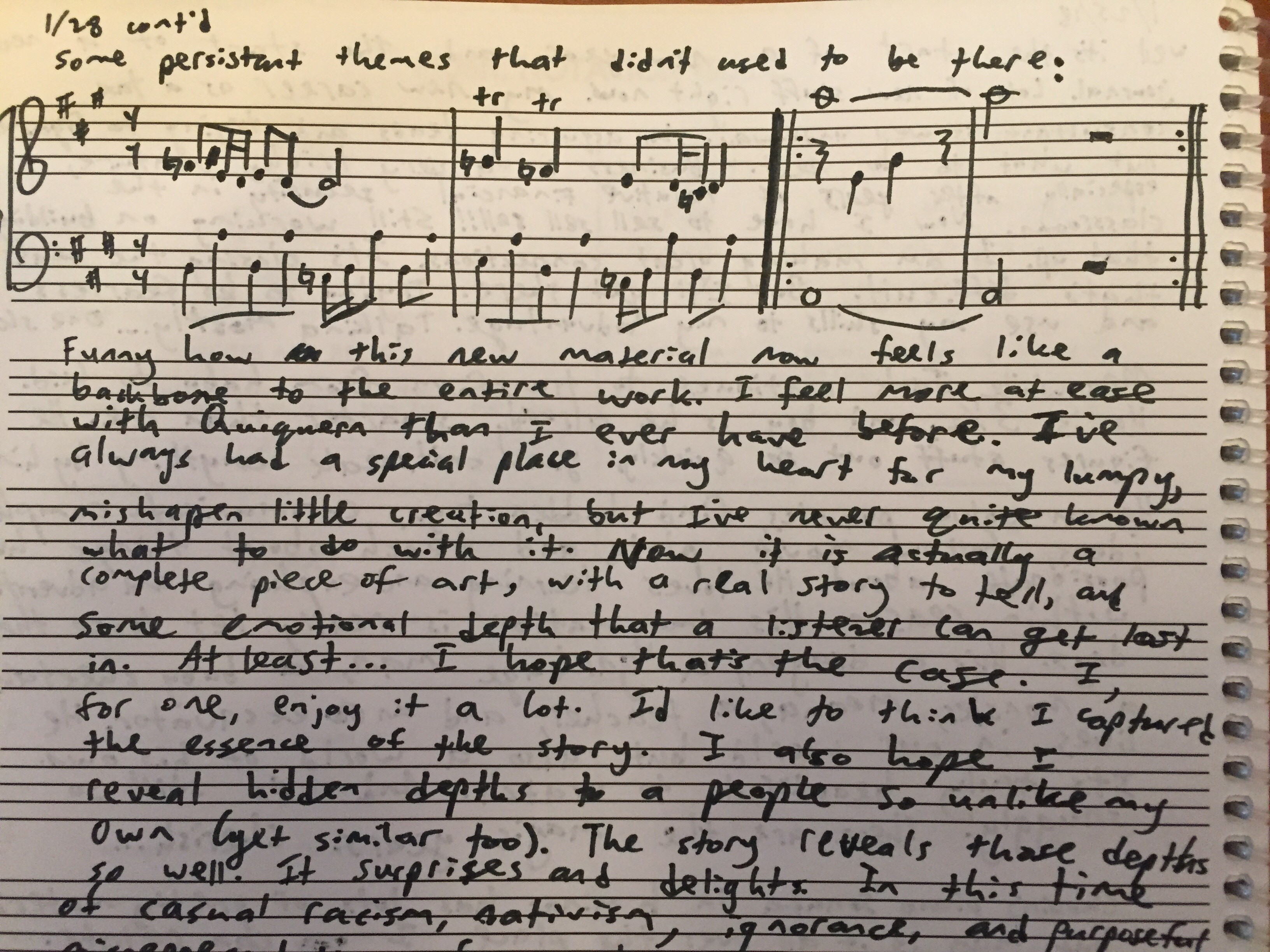
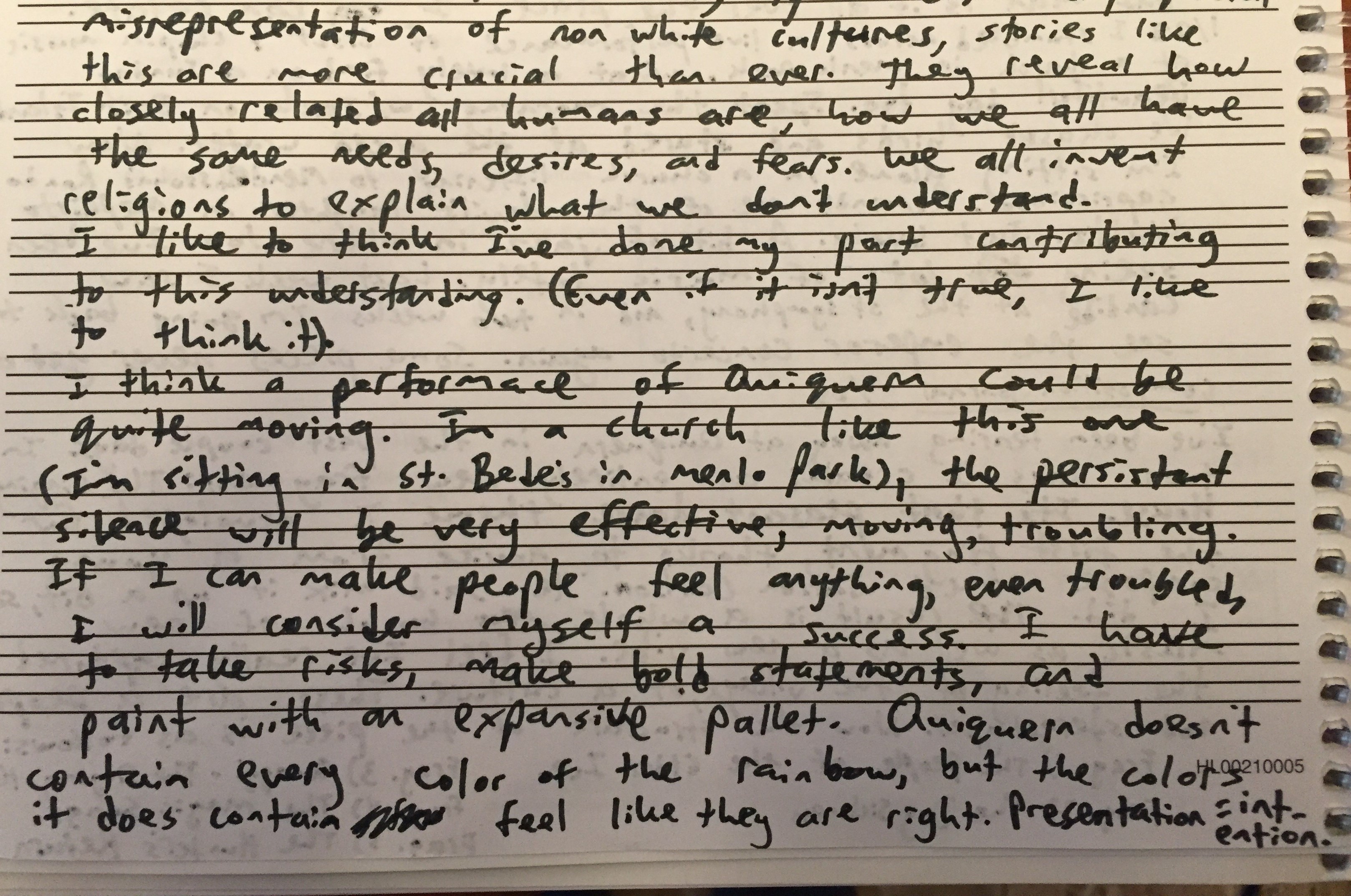
Here’s the piece I was listening to as I wrote this:
You can read more about Quiquern here.
Quiquern: Village Dance
Here’s the new version:
I posted what I thought was a complete movement on a favorite forum of mine, the Young Composers Music Forum, (here’s the post). A young composer named Jarron Carlson posted a very thoughtful response:
“Thank you for sharing this (wonderfully poetic!!) music! I love your use of motifs and how creative you are with your harmonic language. Especially in the first movement, I really admire your use of more traditional harmonies how they slip into sonorities that are more modern-sounding. I do wish however, that you exposed us to more variety in texture in the first movement. I feel like most of the piece you stick to the feel of (for lack of a better word) intruding silences and pauses preceded by short melodic phrases. Maybe you were going for this feel throughout the whole movement, but I sort-of wish I got the chance to hear you develop your motivic ideas in a different kind of texture. Texture change can also be very effective for communicating different emotions to your audience (which I read was one of your goals in this piece and I feel like you’re already doing well already, with your writing as it is :)”
That critique really struck home. Quiquern has always been one of my children, and I love her dearly, but she has never been perfect. One persistent problem across the years has been a lack of diversity of sound. There are lots of lovely segments of Quiquern, but when taken together they tend to blend into something long and monochromatic (a touch of which I was going for, as I wrote the music picturing a frozen tundra, but too much can be too much). Throw in a new texture, mix in some beloved themes previously heard, and BOOM magic happens. A fire was lit! I mean shoot, I had enough material to work with!
By the way, you can check out some of Jarron’s work at his Soundcloud: https://soundcloud.com/jarron1099.
I don’t often compose quickly, but this stretch was fast. Statistically now it has been proven that I almost always very musically productive in late December. My Song-Writing Club took place in December, as have many feverish bouts of creative activity. I started the new section the evening I received the critique (Dec. 13), and completed the new section New Year’s Eve (Dec. 31). Just under 20 days to complete about seven minutes of new music; for me that’s pretty dang quick.
I took the main Quiquern theme and wove it a kind of lively folk dance, the piano strumming like a guitar, a people dancing in the firelight. The woodwinds play all sorts of little games together, chase each other across the ice. There is something festive about this music, but still somber. Just beyond the warmth of that fire is an endless frozen wilderness. It is bitterly cold out there, so cold a man’s skin can freeze off his bones, so cold you go mad. Something is lurking out there, in the distant dark. It could be a god or it could be a monster, or perhaps the wind. Right here, safe by the fire, with my family all around me, I am safe and warm. I celebrate that warmth and cherish it, while I still have it. I pray that all those who don’t have it may find it soon.
How to express a people through music… How to express all the depth of the human experience, all the moments and understandings shared among a tribe… It feels like an impossible task. But at least I feel I added another layer. I wanted these people to celebrate who they are in this music, to have a little fun, to play and wrestle and love. At the edge of the world, surrounded by danger, I wanted them to dance.
The image on this page is my an artist named Milo Minock, who meticulously documented the goings-on of the Yup’ik tribe in the 1950s and 60s. Read about his work here.
Sketching a symphony
I’m writing some music for my friends. More on that in a bit.
These little nuggets will one day become my first symphony. I guess wouldn’t exactly call them sketches since the music is written beginning to end, but they feel rough because they are not yet fully orchestrated. Either way, once that final orchestration phase is complete, this work will be a substantial piece of music, with a lot of rich content for the listener to explore.
For now I’ve chosen a basic instrumentation of flute, oboe, trumpet, low strings. This can give a feel of being fleshed out, but is small enough to make sketching manageable, and colorful enough to make it fun. This instrumentation also helped me get away from the violin-centric symphony model, since I haven’t included violins in my original sketches. When I sit down and orchestrate this thing for real I will add violins in at my leisure, like a painter who, with one smooth movement, adds a bit of reflected light to a child’s eye.
The next step is to dive deep into the orchestration and make some hard choices. But for now, I’m savoring the completion of an crucial leg of this artistic journey. This particular piece has taken years to get to this spot, and where it will eventually lead I am not entirely sure. Sometimes it’s just important to pause and recognize a milestone.
The working title is “Adventure Cat!”. I’m not totally settled on all aspects of this music, but the overall arc I love. This is music for my friends. It’s a celebration of what we’ve all accomplished together, what we’ve built, the life we’ve lived, the love we’ve felt. The music goes a lot of different places, as do long friendships.
The music also challenges the ear at times, and other times it’s warm and inviting. It tries to take he listener on a road trip, over a fence, into the dark night. Sometimes it’s a song of love, a private moment, a hidden cave.
When I dive back into this music and turn these nuggets into completed symphony movements, I may end up expanding certain chunks, or slowing down the tempo for a section, or taking the music in a slightly different direction if the mood strikes me. I’m still shaping the clay a bit. But the meaning behind the music will not change. It’s that meaning that underscores every note of this music, every rise and fall. It’s that meaning that drives me to complete it.
I welcome any feedback.
Quiquern Part Two: The Dog Sickness
Today I finally completed part two of my piece called “Quiquern.” This movement is called “The Dog Sickness”. (Click here for part one).
I thought “Quiquern” was complete years ago. Time and again I would declare it officially finished. But then, months later, something just wouldn’t sit right with me. I’d pry it open again and tinker with its innards. Maybe it will never be done. Maybe I’m destined to dance with this score til the end of my days.
Don’t get me wrong, I have always loved this music. Every time I pick it up again, I’m reminded of why I have such a sweet spot in my heart for “Quiquern”. It evokes so many positive memories: of writing it over Christmas break in San Diego, of reading The Jungle Book over and over, of experimenting with new sounds (new to me anyways), of unhinging my creativity from purely classical harmonies and letting go a bit. Like this sort of thing:
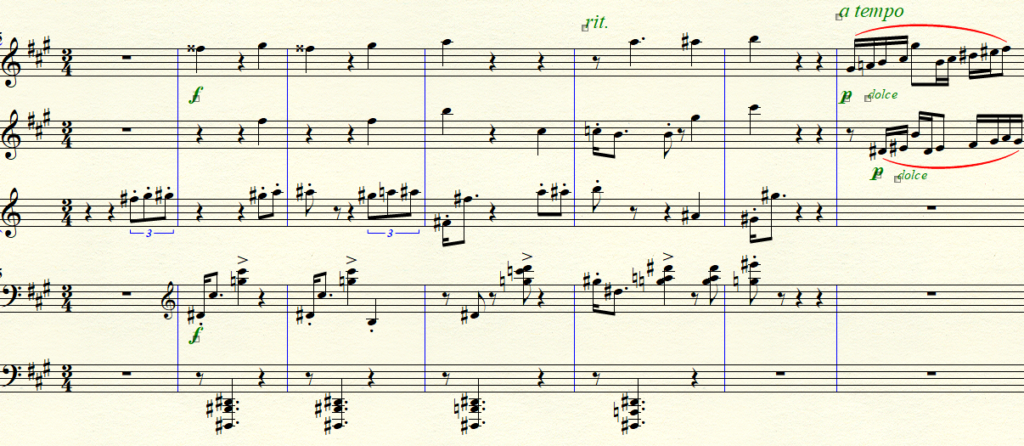
I never go full atonal, I’m always chained in some way to classical forms and progressions, but this piece freed me up in some ways I had never tried. I went wandering a bit through the cold wilderness. I let the images in my mind solidify into a color palette. I focused on the story the sounds told, rather than fussing about the progression. This allowed me to express all the pain I felt after reading that beautiful, heart-breaking story.
So why, if this music was so compelling, couldn’t I call it “complete”? Well there were a few reasons. One is I just wasn’t thinking about form when I first wrote it. I was in “crank it out” mode, writing down whatever ideas popped into my head. I tried to free up my creative process and stop self-editing as I wrote. As a result, the music flowed pretty freely out of my brain, and the harmonies were weirder than I was used to. The musical nuggets that emerged were captivating and exotic. But there was no overarching shape to the piece. It was just idea after idea, with very little connectivity. Throwing a bunch of nuggets into a pile don’t make it a whole chicken.
This time around I wanted to work on that. This is the sort of pre-thought that Schoenberg went on about. In other words, real composers think about form and structure BEFORE writing, they don’t just wander around in the dark hoping to bump into a complete form. When I put some thought into this piece, I was able to picture the arc that I wanted to create with the music. A chaotic, hallucinogenic dream sequence, sandwiched on either side by a poignant but solitary theme calling out in the dead stillness of the ice-fields. Perhaps the middle is what the dogs feel as they begin to starve, giddy and terrified and angry; the beginning is what the Inuits feel watching their beloved animals suffer in the dark, knowing what awaits them if another source of food is not found soon. Or maybe the beginning is a song for a way of life that is slowly dying.
“What is it?” said Kotuko; for he was beginning to be afraid.
“The sickness,” Kadlu answered. “It is the dog sickness.” The dog lifted his nose and howled and howled again.
“I have not seen this before. What will he do?” said Kotuko.
Kadlu shrugged one shoulder a little, and crossed the hut for his short stabbing-harpoon. The big dog looked at him, howled again, and slunk away down the passage, while the other dogs drew aside right and left to give him ample room. When he was out on the snow he barked furiously, as though on the trail of a musk-ox, and, barking and leaping and frisking, passed out of sight. His trouble was not hydrophobia, but simple, plain madness. The cold and the hunger, and, above all, the dark, had turned his head; and when the terrible dog-sickness once shows itself in a team, it spreads like wild-fire. Next hunting-day another dog sickened, and was killed then and there by Kotuko as he bit and struggled among the traces. Then the black second dog, who had been the leader in the old days, suddenly gave tongue on an imaginary reindeer-track, and when they slipped him from the pitu he flew at the throat of an ice-cliff, and ran away as his leader had done, his harness on his back. After that no one would take the dogs out again. They needed them for something else, and the dogs knew it; and though they were tied down and fed by hand, their eyes were full of despair and fear. To make things worse, the old women began to tell ghost-tales, and to say that they had met the spirits of the dead hunters lost that autumn, who prophesied all sorts of horrible things.
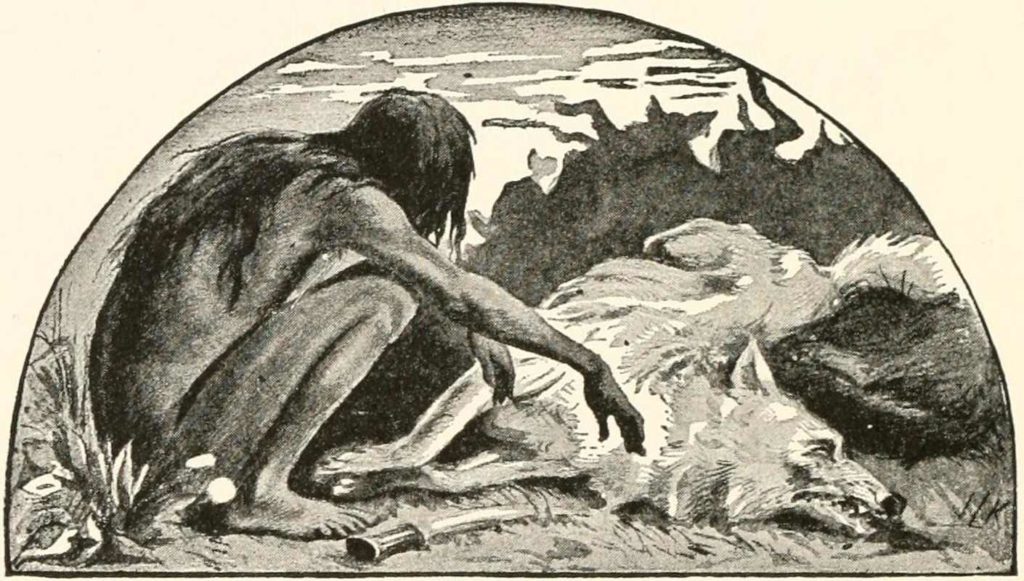
Prayers to a cruel and fickle ice god.
And while I was working on form, I also put more thought into motifs. This piece has a lot of rich material, maybe even too much. Though I love that there are so many fun ideas in there, sometimes it plays like one of those Beatles songs with too many good ideas but no development. This time around I went through the piece with a needle and thread, and wove my favorite motifs into the very fabric of the piece. In and out they come, appearing and disappearing again, becoming more recognizable with each appearance. Just as a chef might pour a bit of the boiling gnocchi water into the sauce to bind all the flavors together, my goal was to bind all the ingredients of this music together into something coherent (and tasty).
Like this motif, which appears everywhere:

Or this rhythmic motif:
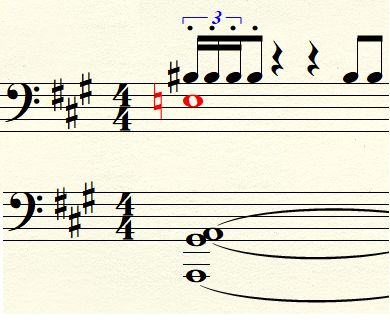
There was something else fundamental that needed retooling: instrumentation. Originally I chose three flutes and piano for this piece, because the flutes evoked the lonely, frozen tundra. But as I was writing, I didn’t pay enough attention to the limitations of the flute. I wasn’t writing in an idiosyncratic way, I was just cranking out music. The used a lot of low C’s on the flute because I liked the sound, but I knew the notes were ringing out stronger in my head than they would on a real instrument, where that low C is easily covered up and lost in the mist. I considered an alto flute, but decided a clarinet would give me a whole other palette to play with.
When one phases in a new instrument like this, one can’t just paste the flute part into a clarinet staff and call it done. The addition of the clarinet changed the whole character of the piece. While the flute is cold and isolated and graceful and metallic, the clarinet is like warm baking bread. It’s also intense, frenetic, a bit insane at times, with low earthy tones that can feel angry or foreboding or subdued. That new voice greatly expanded the range of the piece, so I was able to open the music up a bit and let it breathe.
All these forces combined into something much different than the piece I’ve been kicking around all these years. This version feels like a completed piece of art. It’s not just a sketchbook of ideas, it’s a story arc with real meaning. In other words it really does feel done. For real this time. Seriously.
This music is about suffering, and in a way the audience suffers a bit as they listen. It is not over quickly. But the music is also about hope, and the idea that suffering is a part of life, and doesn’t necessarily cancel out the good. There are joyful memories mixed in with the pain. There is a dream that soon the pain will end. Yes there is fear, yes there is chaos and anger. But the sun still rises at the end, even if the air all around is frigid.
Quiquern Part One: The People of the Elder Ice
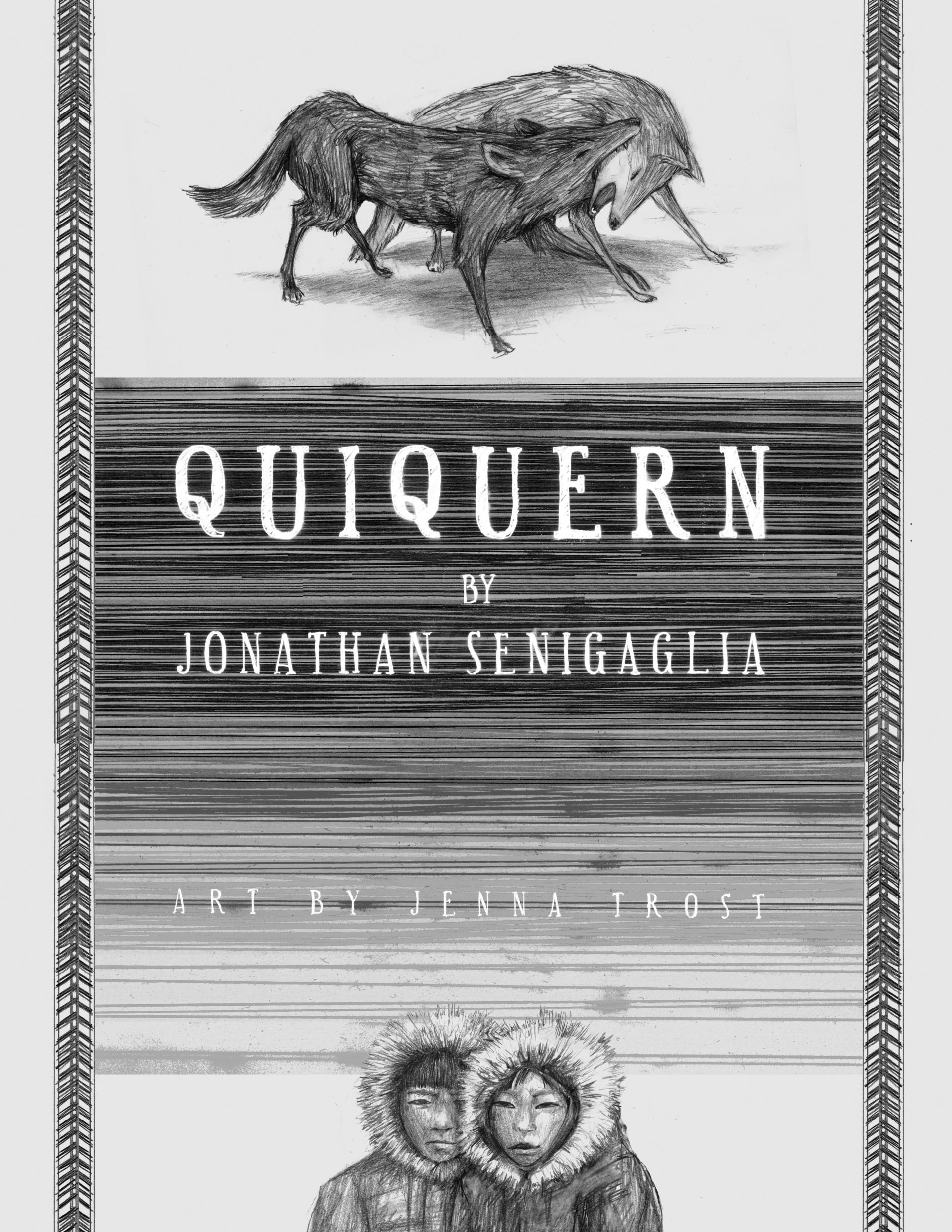
Quiquern Part One: The People of the Elder Ice.
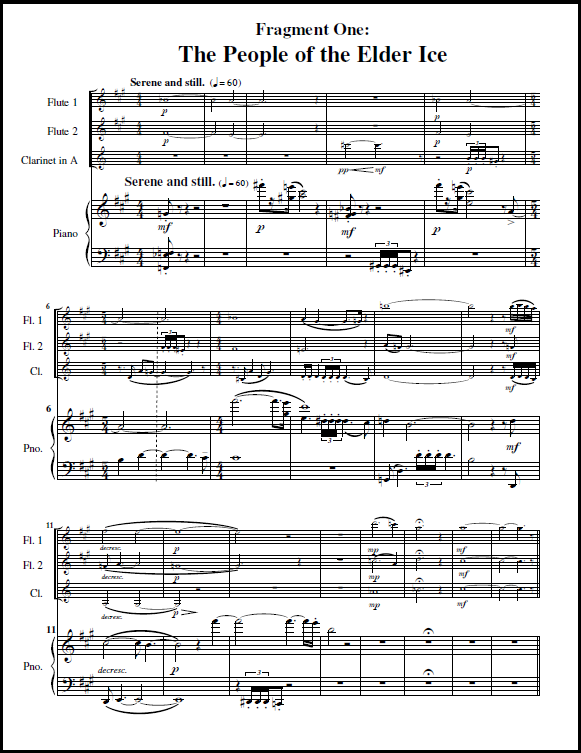
Have a listen while you read:
One of my favorite short stories of all time is “Quiquern” by Rudyard Kipling, from The Second Jungle Book. If you’ve never read the two Jungle Books, I highly recommend them. The Disney film only scratches a tiny surface compared to the epic stories by Kipling (Mowgli’s story is really only the first of like 20 stories). The writing is so crisp, and these stories do what all great sci-fi and fantasy stories do: they create an entire fully-formed world for the reader to explore. The world is rich and complex, and the lessons it teaches are piercing and difficult to shake.
The Disney film is fun and jazzy and hip and carefree; the written stories are raw and wild, filled with the brutal poetry of the jungle. The characters are bound by the laws of the jungle, the unwritten rules and shared understandings that guide every action the animals take. The laws dictate how to behave in times of drought, when and where hunting is permitted, and how to interact with the ever-expanding, dangerous world of Men. Only Mowgli is unbound by the laws of the jungle. Therefore he rules the jungle.
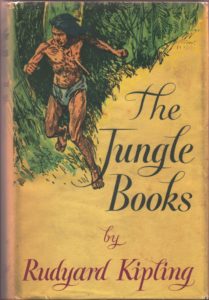
There are also so many hidden messages and deeper meanings packed into Kipling’s verse. Every story begins and ends with poems, the meanings of which change after reading each story. For example, this one:
And his own kind drive us away!
At first reading, it is a nice little poem. But after reading the story that follows it, “The Miracle Of Purun Bhagat,” the poem becomes so tragic and beautiful. Every story has these lovely little nuggets, and they make the reading experience so rich.
“Quiquern” is the story of a young Eskimo boy who lives in a tiny village surrounded by a frozen arctic wasteland. The village’s only source of food is seal meat which they catch with the help of their many well-trained dogs. One particular dog is born a runt, shrunken and sickly in the freezing wind. However the young boy cares for the dog, and raises him as a member of his own family. His love for the dog is pure and innocent, and together they frolic in the snow like siblings.
One year the winter is especially harsh, and the ice does not recede. The surplus seal meat runs out, and the people of the village soon begin to starve. In their moment of desperation they eat the wax from their candles, the leather from their belts. Their beloved sled dogs, still chained together in groups of eight, insane with hunger and fearing for their lives (just as lion cubs must fear their mother in times of hunger) break their chains and run screaming into the white waste. The people of the village become living skeletons.
The boy and a young girl from the village, still strong in their youth, announce to the village that they will venture out into the ice storm and find food for the village. It is suicide, but nobody stops them. Within days of their departure they are hopelessly lost, freezing, and beginning to hallucinate. They kneel shivering in the snow and announce to the heavens that they are man and wife. As darkness closes around them they pray to Quiquern, the eight-legged spider god of the arctic, for salvation and mercy.
The two children open their eyes to see a massive creature barreling toward them in the distance, eight legs scurrying effortlessly across the snow. A giant, hulking body becomes larger and larger in the morning haze. Quiquern has arrived to devour them; they are helpless as newborn seals. It is the end of their short lives, the end of their people. Two freezing, starving children prepare to die alone on a frozen plain at the edge of the world.
However as their eyes focus, they realize that the eight-legged creature is actually two dogs, running wildly through the snow pulling an empty dogsled. The dogs are well-fed and excited, blood dripping from their snouts. At the front of the pack is the runty dog the young boy once saved, frothing with joy at the sight of his oldest friend.
Carried by the sled dogs, the two Eskimos travel for miles to an open pit in the ice, where fat seals emerge for air. The dogs had found the hole in the ice and gorged themselves on meat. The boy and his wife fill the sled with food and return to the village as heroes. The village, now inhabited only by ghost-like creatures with sunken eyes, celebrates by burning whatever candles they have left. An ancient people go on.
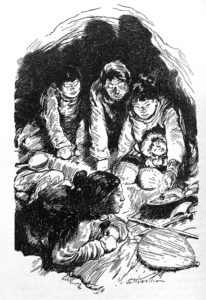
This story burrowed down inside me and left its mark on my soul. I’m not sure why, I can’t explain it, but it filled me with the urge to write music. Originally I set out to write something eerie and cold and empty, three flutes crying out across the Arctic plain. But as I wrote, I realized it needed some bass, so I worked a piano into the mix. Years later, I switched out a flute for a clarinet to give it one more color, and that ensemble is the one that remains.
I’ve always loved my piece, Quiquern, just as I’ve always loved the story Quiquern. I can’t exactly say what it is that draws me to both, but drawn I am. Over the years I’ve written notes about this music in the margins of my journal: “Don’t forget, you love Quiquern. Don’t discard it.”
The artwork at the top of this post is by the very talented artist and sculptor Jenna Trost. Please visit http://jennatrost.com/ to see more of her lovely work.
The music you’ve been listening to is the completed first movement of this work, which is called “The People of the Elder Ice”. I hope you’ve enjoyed it. The entire middle section of this movement, which I refer to as “Village Dance,” was actually added later. Read about that addition here. For Part Two: “The Dog Sickness,”Click here.
San Rocco a Pilli
San Rocco a Pilli
In the scorching heat of midday the villa was abandoned, deserted, post-apocalyptic. I hunted across the grounds, running my fingers through the golden Tuscan grass, snooping down dark hallways and looking out the ancient, cloudy windows that appeared to be made of clear honey, though they felt solid to the touch. I wandered into a giant barn. No farm equipment or hay, just faded wood panels and a colony of snoozing birds that had taken up residence in the rafters. The high ceiling and heavy, silent air reminded me of a cathedral; solemnly I knelt to inspect an old nail on the floor. Anxious to hear any type of sound, I lightly rapped the rusted door with my shoe, and the birds suddenly took flight in a panic of feathers and chaotic squawking, swooping down savagely at the invader, filling the previously silent space with noise and anger. I covered my face, perhaps in shame at how thoroughly I had destroyed something so serene, and ducked out the door into the burning sunlight, leaving the birds to return to their prayers. The hot, fallow fields and gentle hills in the distance looked on, unphased and without judgement.
A single gust of breeze meandered past the sweat on my neck, providing just the faintest hint of cool. I breathed deeply, filling my lungs with the air my ancestors breathed so many hundreds of years ago, when the villa at San Rocco was a powerful fortress guarding the countryside, a pillar of strength. Today the villa still stands a lonely guard upon its abandoned hill, but it’s empty and choked with native weeds, its only occupants birds who sing lustily from the treetops and build their nests in the red roof tiles. The outer walls of the buildings all have loops for tying up horses, but there are no horses that need tying up, and rusted farm equipment sits neatly in a line along the field’s edge, more as a creepy decoration than as tools ready for hard use. I dunked my head in a pool of cool water, and hid from the sun in a cobwebbed vestibule that no doubt once offered shade to a 17th century farmhand after a long day’s work. Sitting against a post in the shade, I began to dose. Two tiny birds flew in to get some shade and woke me from my brief nap, but upon seeing me there they departed in disgust. Wrapped tightly in the silence of the afternoon, I let my mind wander the fields.
Why do I find myself feeling jealous of these happy Tuscan birds? As I drift across the countryside searching for something that will lend meaning to my life, these small creatures are content to lay in the sun, to cool their feathers in a pond, to sleep the day away in the rafters of an old barn. Life seems to have purpose and no purpose all at the same time. One day I will disappear and be forgotten, perhaps as if I never existed, much like my ancestors who lived in Italy for hundreds of years, of whom no record exists, whose lives have been utterly forgotten by posterity, entire lives full of laughter and sadness and sex and longing and glorious moments and religion and debate and watching the sun set in the hills and babies born and tragedy and art, erased and forgotten; just as the two birds who flew into my vestibule might never have existed at all, and perhaps lived only in a dream, a dream which I am already beginning to forget. I’m sorry little birds! I don’t want to forget you. I want you to live forever, wild and free in the Tuscan sun. But if you must be forgotten, I want you to live your lives with reckless happy abandon. I want you to drink the air with hearty gulps and dance in the breeze and dive like missiles. I want to join you. Then we can be forgotten together, but we won’t care because we will be birds, smooth and fast, and we’ll make our nests in the tiled roofs of old villas.
Back inside the cool, dusky main house I glimpsed the curvy figure of a piano tucked away in the darkness. The instrument called my name, beckoned me seductively. I approached in a trance. Staring transfixed at the candlestick holders bolted to the wooden frame, I reached desperately for her smooth, white keys. But sadly when she finally felt my tender caress, she could only respond with the dull creak of decrepit age. Dust choked the arteries that once pumped sweet music down these old halls. The piano and I wept together as two lovers who have irreconcilably grown apart. I did not touch her again.
I wandered down a hallway filled with ghosts. A laughing cavalier smirked at me as I tried a locked door. Though the sun still boomed through the open window, the hallway grew more ominous as I crept down toward the dead end. This hall was different from the others, more silent, more deserted, painted differently – as if the craftsman rushed to complete his job and be away from this place. I felt something slide under my skin, an urgency, the instinct to flee. These old ghosts are not scared of the burning noon sun. They are Romans and Tuscans and hard men, and they can smell the softness of my pampered hands, the hands of an untried and cocky young man who fancies himself an adventurer. They mock and beckon. Feeling their presence, I fled in shame and with much haste. Put me on a train back to Rome, get me out of San Rocco, before I join the ghosts and become another smirking face in some faded painting, inviting naive tourists down well-lit hallways that reek of death and lead paint.

